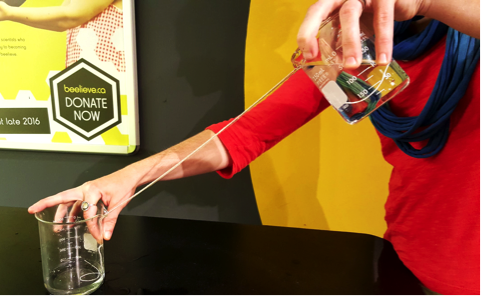There’s nothing more refreshing than a cool drink of water on a hot summer day.
Plants need water just as much as we do, but they can’t exactly turn on a tap when they’re thirsty.
So how do plants drink their fill?
In this Let’s Discover experiment, we’re going to get to the root of the question, but to do so, we’ll need to dive deeper and explore transpiration. Transpiration is basically the process of water evaporating from tiny openings on the surfaces of leaves. The evaporating water cools the plant, just like sweating cools people and some animals.
More than just cooling off, transpiration plays an important role in how plants ‘drink’ water. The evaporating water creates a ‘pull’ through special plant cells, dragging water up from the roots, through the stem, and out to leaves. This trip, a fight against gravity, is possible because of a strange property of water: its ‘stickiness.’
We can see water’s stickiness in action with this simple water experiment:
Materials
- Two glasses or glass jars
- Water
- Approximately 60 cm of string/butcher’s twine (must be absorbent)
- A towel to clean up any spills
Procedure
- Fill one glass halfway with water.
- Cut approximately 60 cm length of cotton string/butcher’s twine and soak it thoroughly in the water.
- Keep one end of the string submerged in the glass with water, and with your other hand, hold the opposite end of the string over the empty glass.
- Raise the cup with water up, and gently pour the water down the string while holding the string inside the water glass with your finger (see above image).
Did you find that the water stuck to the string on its journey to the empty glass with hardly any spillage? Congrats! You’ve discovered that water molecules are polar!
Thirsty Plants!
In the second installment of this experiment, we’ll look closely at the stickiness of water and how plants defy gravity (with the help of plant cells) by pulling water up until it reaches the most outer surfaces. You can see for yourself by doing this colourful (and rather tasty) plant experiment!
Materials
- Glasses or jars filled with water
- Food colouring
- A leafy bundle of celery
Procedure
- Fill the jars with water and different food colours. For crafty bonus points, try forming the colours of the rainbow.
- Separate individual stalks of celery and cut off the bottom so they can stand up in the jar (leave the leaves on)
- Place one stalk in each jar and allow them to sit for a number of hours, ideally overnight
- The next morning, check the leaves. Notice anything different? Cut the leafy top off one of the celery stalks – can you see the plant cells?
- Compare the celery stalks and plant cells in your experiment to a regular stalk of celery.
- What colours did you find worked best?
How plants take up and transpire water are critically important parts of our water cycle. Learn more about plants in the Discovery Centre’s latest Nature Scopers film series on plants and seeds. You can also visit the latest interactive Exhibit, Ocean Bound! and discover water’s journey through our world, on now at the Discovery Centre until September 6!
For more great things to discover – visit the Discovery Centre on Barrington Street in Halifax, check out their website or join them on facebook.





